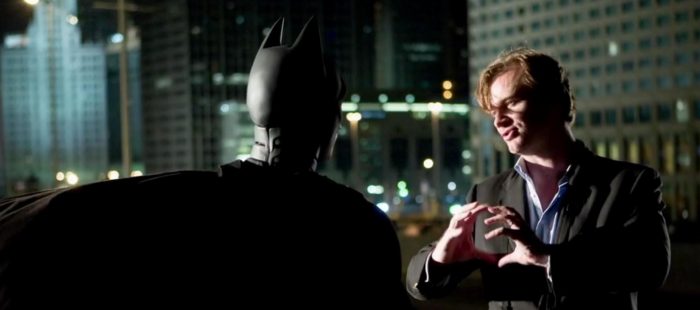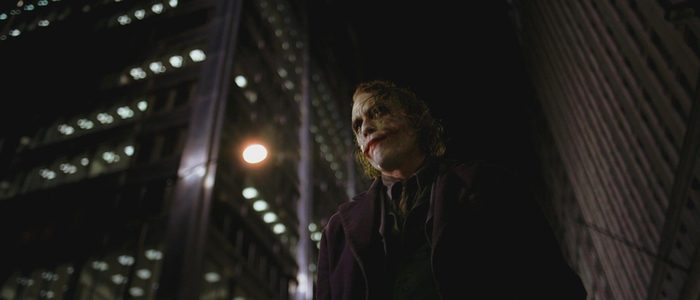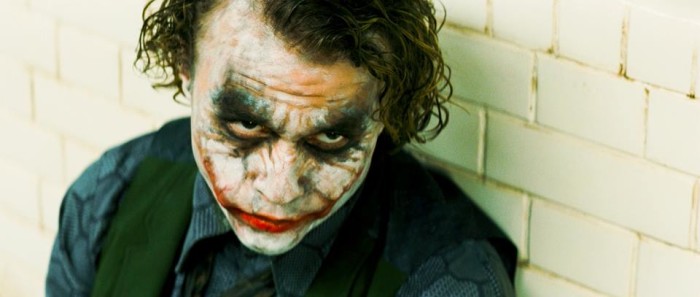How ‘The Dark Knight’ Plays With the Theme of Identity

(Welcome to The Dark Knight Legacy, a series of articles that explore Christopher Nolan’s superhero masterpiece in celebration of its 10th anniversary.)
Here we are: 10 years later and we’re all talking about The Dark Knight again. But why is this film so widely regarded? One answer: The Dark Knight weaves its story around the identities of its characters in a way that molds the movie into how we perceive it today.
The Dark Knight, released in 2008 and directed by Christopher Nolan and written by Nolan, his brother Jonathan Nolan and David Goyer, is a sequel to Batman Begins and continues Nolan’s dark and gritty take on the character. The movie opens with a robbery; it is, unknowingly at first, our first introduction to the Joker, played by Heath Ledger. Not only is his identity concealed from us, but it is also hidden from the low-level henchmen whose skill set allows him access to the bank in the first place. It’s the first instance in the film that we see how malleable the Joker’s identity is. He is orchestrator, participant, goon, and the now lucky recipient of $68 million all at once. And he doesn’t even want the money.
The movie makes sure to get across how unattainable the Joker’s true identity is. From the constantly changing story about the origin of his scars to the Joker manipulating Harvey in the hospital into thinking that he was just an aimless wild dog without a plan when he is the exact opposite, this shifting in identity and personality creates a persona of its own. Something not quite tangible. This is what makes him such a treat to the audience and a complete foil for Batman/Bruce Wayne (Christian Bale).

Batman comes into his own in The Dark Knight. Losing his family home hasn’t slowed him down in the least. He shows up on the bank robbery scene all business, engulfed by the case before him so much so that he neglects to return home, where Alfred finds his bed empty. Instead, Bruce spends all his time investigating in the makeshift bat cave. Unlike the Joker, Bruce is definite in the fact that his identity is that of Batman – the mask is Bruce Wayne.
Alfred brings up the fact that he is neglecting his other life by saying, “Know your limits, Master Wayne.” Bruce responds with “Batman has no limits,” distancing him himself from his ailing human form and instead adopting that of the symbol of Batman. The film takes this conflict with identity to heart. Through the film, we watch as both Bruce’s and Batman’s life converge.
The focal point of the Bruce-Batman identity rests with Rachel Dawes (Maggie Gyllenhaal). It’s unfair and reductive to take the only female lead and make her a character who only exists to further the male characters development and plot (one of the main problems with an undeniably iconic movie), but let’s focus on her weaponization by the Joker to destroy the identities of Batman and Harvey Dent.

Rachel’s romantic involvement with Harvey Dent (Aaron Eckhart) allows Bruce to recognize that Dent is the real savior of Gotham and could help him hang up the cowl for good. Using the classic “it’s them or me” ultimatum, Rachel offers Bruce the opportunity at a normal life if he leaves Batman behind. While a healthy life as Bruce could be appealing, Batman knows that his Bruce persona is only a mask to be worn.
Rachel also serves as a catalyst for Dent. When we first meet Harvey, he is Gotham’s new fearless district attorney, working hard to get crime off the streets. Dent is all consumed with his job and cleaning up Gotham. It is apparent that he loves Rachel, but more evident that he is dedicated to the city first and foremost. Just like Batman, Dent’s loyalty lies in the job he as to do, not in love. This is solidified when he adopts the identity of Batman to keep the city safe and give the real Batman a chance to actually apprehend the Joker. But Harvey has a dark side, a desperation so real when he perceives those he loves are in danger.
Rachel’s role in the identities of Batman and Dent become even more apparent after the Joker names the mayor as one of his victims. The assassination fails, but Dent finds one of his men wearing a tag that says “Rachel Dawes” and he kidnaps the man to question him himself. His methods are violent and irrational. The white knight is gone, and this unhinged man is in his place. This is the first time we as an audience see why the cops called him names behind his back. Dent’s White Knight identity disintegrates the minute Rachel dies. He has become Two-Face.

Rachel’s death also brings about Bruce’s realization that he can’t flip-flop between identities. The moment Batman realizes that the Joker switched the locations of Dent and Rachel, he realizes that he is dealing with a whole new league of villain. With Rachel gone, he is committed fully to being Batman and leaving those “Happily Ever After” dreams behind.
The Joker’s actual goal in this entire film is to show Gotham the true identities of both Harvey Dent and Batman, literally and figuratively. Also, as a narcissist, it can be put forth that the Joker really just wants to be Batman’s one and only. He pulls out all of the stops. He wants to unmask the vigilante and put a human face on the godlike symbol, all while dehumanizing the White Knight and savior Harvey Dent. All of the Joker’s actions focus on manipulating their lives to get at the core of who they are and he succeeds. His actions pull out the dark and twisty essence of who Harvey Dent was and is, and he takes away the one reservation that made Bruce want to be Bruce and not Batman.
The Dark Knight is a film steeped in the ideas of identity. Christopher Nolan plays with each character’s double lives, bouncing them off of each other to reveal their core. The real Bruce has always been Batman, and Harvey Dent was one crisis away from turning into the kind of criminal he puts in jail.
The post How ‘The Dark Knight’ Plays With the Theme of Identity appeared first on /Film.
from /Film https://ift.tt/2zSLRQt
No comments: